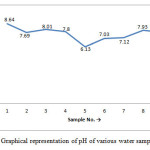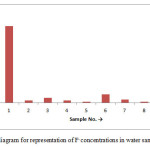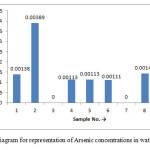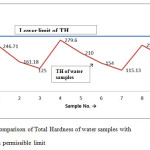Quality assessment of drinking water from Dimapur district of Nagaland and Karbi-Anglong district of Assam for possible related health hazards
Amrit Puzari1 , Pralay Khan2 , Dheeraj Thakur2 , Manish Kumar2 and Kumar Shanu3
Corresponding author Email: amrit09us@yahoo.com
DOI: http://dx.doi.org/10.12944/CWE.10.2.29
Quality of drinking water always remains a sensitive issue since contaminants like Arsenic, Fluoride in excess amount cause serious health hazards. Arsenic in drinking water causes harm to physical and mental health of a person and this may even cause cancer and damage to blood vessels and heart. This may also cause reproductive problems and birth defects.Several states of India are known to be effected arsenic contaminated water which leads to serious illness. Uttar Pradesh, Bihar, Jharkhnad, West Bengal, Assam, etc. are examples of such states. Arsenic related illness has also been reported in Manipur. Similarly presence of excess fluoride in drinking water causes mild dental fluorisis to skeletal fluorisis. It is also equally important to maintain prescribed standard of the other drinking water ingredients. Quality assessment of drinking water from Dimapur district of Nagaland and Karbi Anglong district of Assam has been presented in this paper. Quality assessment has been accomplished by measuring various quality parameters in drinking water collected from different random locations of the two districts. Quality parameters like ‘Alkalinity’, ‘Hardness’, ‘pH’, ‘Arsenic’ and ‘Fluoride’ concentration etc. are determined during the course of the study. Based on the values of the quality parameters, a rational analysis has been made about the quality of drinking water.
Copy the following to cite this article:
Puzari A, Khan P, Thakur D, Kumar M, Shanu K, Chutia P, Ahmed Z. Quality assessment of drinking water from Dimapur district of Nagaland and Karbi-Anglong district of Assam for possible related health hazards. Curr World Environ 2015;10(2) DOI:http://dx.doi.org/10.12944/CWE.10.2.29
Copy the following to cite this URL:
Puzari A, Khan P, Thakur D, Kumar M, Shanu K, Chutia P, Ahmed Z. Quality assessment of drinking water from Dimapur district of Nagaland and Karbi-Anglong district of Assam for possible related health hazards. Curr World Environ 2015;10(2). Available from: http://www.cwejournal.org?p=747/
Download article (pdf)
Citation Manager
Publish History
Select type of program for download
| Endnote EndNote format (Mac & Win) | |
| Reference Manager Ris format (Win only) | |
| Procite Ris format (Win only) | |
| Medlars Format | |
| RefWorks Format RefWorks format (Mac & Win) | |
| BibTex Format BibTex format (Mac & Win) |
Article Publishing History
| Received: | 2015-03-03 |
|---|---|
| Accepted: | 2015-05-22 |
Introduction
Water has profound influence on human health.1,2 Every individual requires a minimum amount of water per day for survival and in other words without water life is just impossible on earth. Therefore human health broadly depends upon quantity and quality of water supplied to them.3 Thus whenever we talk about improvement of public health, the issues like accessibility of quality drinking water, microbiological quality of water, quantity of water available for mass population and the relative cost of water being supplied must be addressed. However water quality aspect is not the sole determinant of health impacts.
Poor microbiological quality often leads to outbreak of infectious water-borne diseases.1 Presence of chemical water pollutants in significant amount might leads to chronic long-term health effects. Specifically excessive amount of Fluoride and Arsenic concentration in drinking water cause serious health impacts.4,5 Arsenic in it’s elementary form is very toxic and is also carcinogenic.6 Presence of very little amount of arsenic in water might even cause severe harm to human health.7 However elementary arsenic does not react with water in absence of air. It reacts only with moist air. Arsenic compounds are abundant on earth and they are released during mining. Arsenic from weathered rocks and soils dissolves in ground water. More significantly concentrations of arsenic in water are relatively high in areas with geothermal activity.7,8 Arsenic compounds are used for different purposes like in semiconductors with Gallium and Indium, as insecticide and fungicide, as pesticide in viticulture etc. Arsenic compounds may enter the body less specifically through food intake.
Similarly presence of excess amount of fluoride in drinking water also causes significant health effects. Fluoride-pron diseases are related to body’s fluoride content which in turn related to exposure of human being with different forms of fluoride. It has been determined by The Institute of Medicine, Food and Nutrition Board that an adult human body and children above 8 years cannot tolerate more than 10mg of fluoride per day. However fluoride contamination is not always harmful and when the concentration is low such as 1 mg/L, the contaminated water is considered beneficial for teeth and that can even prevent tooth decay. Lack of adequate amount of fluoride in water makes the water unhealthy for drinking purpose and persons consuming such water may suffer from tooth decay and dental caries. Again dental and skeletal fluorisis might result from consumption of water containing higher concentration of fluoride.9 According to some school of workers lung and bladder cancer can also arise from fluoride contaminated water. But no convincing documents are found in support of this fact. Other parameters like pH, Alkalinity, Hardness, Dissolved solids etc. are equally important in ascertaining the quality of drinking water. Keeping in view all these facts, authors envisaged to determine the quality of drinking water from Dimapur district of Nagaland and karbi Anglong district of Assam, with the broad objective of finding out any possible health hazards associated with the same.
Material and Methods
Water samples were collected from various random locations of these two districts so as to ensure maximum area coverage. Water samples from different locations of the two districts were collected in plastic bottles and the bottles were cleaned properly before use (washed with detergent, dil. HNO3 and deionized distilled water). Ground water samples immediately after collection, were acidified with dil HNO3 (5N) solution. The samples were analyzed for different parameters like Arsenic and Fluoride content, pH, Alkalinity, Total hardness and the like. Only ground water samples were subjected to arsenic test as the chances of finding arsenic in ground water is much more than getting it in surface water.
Samples for the study were collected from the following locations as shown in Table 1:
Table 1: Description of source of samples
|
Sample No. |
Location |
Type of water |
District |
|
1 |
Manjha police station,Diphu |
Ground water |
Karbi Anglong district (Assam) |
|
2 |
Manjha recreation park, Diphu |
Surface water |
|
|
3 |
Diphu town |
Surface water |
|
|
4 |
Diphu town |
Ground water |
|
|
5 |
Lahorijan |
Ground water |
|
|
6 |
Padum pukhuri village,Dimapur |
Surface/lake water |
Dimapur district (Nagaland) |
|
7 |
Sukhovi, Dimapur |
Surface water |
|
|
8 |
Dimapur town |
Ground water |
|
|
9 |
NIT Nagaland, Chumukedima, Dimapur |
Ground water |
Hardness of water sample was determined by complexometric titration method using standard EDTA solution and Eriochrome Black T as indicator. Similarly conventional titrimetric methods was used to determine the alkalinity of water samples. For pH measurement, EUTECH (pH 510 model) pH meter was used. The Thermo Scientific iCE 3000 Series Atomic Absorption Spectrophometer was used to determine arsenic concentration in drinking water samples. Fluoride concentration in drinking water samples were determined by using Thermo Scientific Orion Sure – Flow Fluoride electrodes (Model No. 9609 BNWP).
Results and Discussion
It has been revealed that pH range of water samples are ranging from 6.13 to 8.64 while the permissible range of pH is 6.5 to 8.5. It is also apparent from the data that except for sample No. 1 and sample No. 7, pH of all other samples are within permissible range. Sample No. 1 is slightly more basic while sample No. 7 is slightly acidic (Table 2 and fig.1). Fluoride content (F-) vary from 0.3 – 2.5 ppm. According to WHO (1996) the permissible limit of F- concentration is 1 – 1.5ppm.10 For Dimapur district, it has been observed that all the samples of water have lower F- concentration (Table 2, and fig.2) which is quite below the standard lower limit. Very low value of F- concentration renders the drinking water unhealthy for drinking purpose. Particularly for Dimapur town, F- concentration is too low. For Karbi Anglong district, samples analyzed from different locations indicates that except for Manjha Police station, other water sample contains insufficient amount of fluoride (Table 2, fig.2). On the other hand water sample collected from Manjha police station contains excess amount of fluoride. Overall, it can be ascertained that apparently drinking water quality in Karbi Anglong district is also not up to the mark. Insufficient amount of fluoride might lead to the health problems like dental caries and tooth decay. Again higher concentration of fluoride may result in dental and skeletal fluorosis. Physico chemical parameters of various water samples are tabulated in Table – 2.
Table 2: Physico – chemical parameters of water
|
Sample No. |
Type |
pH |
Total Hardness (TH) (mg/l) |
Alkalinity (mg/l) |
Arsenic (µg / l) |
F-(ppm) |
Electrical Conductivity (µS / cm) |
TDS (mg /L) |
|
1. |
Ground water |
8.64 |
246.71 |
118 |
1.38 |
2.5 |
570 |
412 |
|
2. |
Surface water |
7.69 |
161.18 |
38 |
3.89 |
0.08 |
50 |
150 |
|
3. |
Surface water |
8.01 |
125 |
59 |
---------- |
0.16 |
320 |
274 |
|
4. |
Ground water |
7.80 |
279.60 |
43 |
1.13 |
0.07 |
820 |
546 |
|
5. |
Ground water |
6.13 |
210 |
107 |
1.13 |
0.04 |
84 |
84 |
|
6. |
Surface water |
7.03 |
154 |
74 |
1.11 |
0.27 |
180 |
190 |
|
7. |
Surface water |
7.12 |
115.13 |
14 |
---------- |
0.10 |
140 |
162 |
|
8. |
Ground water |
7.93 |
252 |
47 |
1.43 |
0.03 |
80 |
98 |
|
9.. |
Ground water |
7.68 |
1138 |
182 |
1.10 |
0.38 |
610 |
390 |
 |
Figure 1: Graphical representation of pH of various water samples Click here to View figure |
 |
|
Various forms of compounds such as Monomethylarsenic acid (MMAA), dimethylarsenic acid (DMAA) etc. are generally found to occure in deeper level of ground water. Consumption of arsenic via water cause arsenic poisoning or arsenicosis. Indian standard for Arsenic concentration in drinking water is 0.05 mg/L.11 Arsenic concentration for various water samples (excluding the surface water samples i.e. sample No. 3 and sample No. 7) are presented in fig. 3. Data presented in the figure indicates that Arsenic concentration in two districts is quite below the permissible limit and there is no immediate threat from ground water Arsenic in these two districts.
 |
|
A comparison was made between the observed ranges of data for various quality parameters presented in this work with corresponding permissible limits separately for the two districts. These are presented in Table 3 & Table 4 for Karbi Anglong and Dimapur district respectively.
Table 3: comparison of observed range of values for quality parameters with the permissible limits for Karbi Anglong district
|
Parameter |
Permissible limit |
Observed range of values |
|
pH |
7.0 – 8.5 |
6.13 – 8.64 |
|
F- |
1.0 ppm – 1.5 ppm |
.04 ppm – 2.5 ppm |
|
TH |
300 mg/L – 600 mg / L |
125 mg/L – 279.60 mg/L |
|
Alkalinity |
200 mg/L (can be extended to 600 mg/L) |
38 mg/L – 118 mg/L |
|
As |
0.05 mg/L |
0.00113 mg/L – 0.00389 mg/L |
|
Electrical Conductivity (EC) |
600 µS/cm |
84 µS/cm – 820 µS/cm |
|
Total Dissolved Solid (TDS) |
500 mg/L – 2000 mg/L |
89 mg/L – 596 mg/L |
Table 4: comparison of observed range of values for quality parameters with the permissible limits for Dimapur district
|
Parameter |
Permissible limit |
Observed range of values |
|
pH |
7.0 – 8.5 |
7.03 – 7.93 |
|
F- |
1.0 ppm – 1.5 ppm |
0.03 ppm – 0.38 ppm |
|
TH |
300 mg/L – 600 mg / L |
115.13 mg/L – 1138 mg/L |
|
Alkalinity |
200 mg/L (can be extended to 600 mg/L) |
14 mg/L – 182 mg/L |
|
As |
0.05 mg/L |
0.0011 mg/L – 0.00143 mg/L |
|
Electrical Conductivity EC) |
600 µS/cm |
80 µS/cm – 610 µS/cm |
|
Total Dissolved Solid (TDS) |
500 mg/L – 2000 mg/L |
98 mg/L – 390 mg/L |
From the two tables it can be stated that alkalinity for water samples from both the district are even below the permissible limit. All water samples have total hardness below the permissible limit and therefore can be considered as safe for drinking. A graphical representation showing the comparison of total hardness of various water samples with minimum value of permissible limit are presented in fig. 4.
 |
|
Usually there are no any potential health hazards from consumption of hard water. Rather it can be considered as a potential source for calcium and magnesium required for the body. However excess amount of hardness in drinking water might lead to some health problems. Excess intake of calcium interferes in the adsorption process of Iron, Zinc, Magnesium and phosphorous in the intestine. Increase in the amount of magnesium salts in the body may cause a change in bowel habits.
Conductivity measurement of the water samples indicate appreciable concentration of dissolved ion. Except for sample No. 4, other samples have electrical conductivity well within the range. Slightly higher concentration of dissolved ions can be predicted in sample No. 4. Amount of total dissolved solids (TDS) in drinking water along with other parameters determines its aesthetic value. Drinking water samples having levels of TDS less than 300 mg/L are usually rated as excellent while water samples while those are having in the range 300 mg/L – 600 mg/L are rated as good. Accordingly sample No. 2,3 & 7 can be rated as excellent while others can be rated as good.
Overall it can be stated that drinking water quality in Karbi Anglong district (Assam) and Dimapur district need to be improved although no serious health issues are found with these water. However excess fluoride concentration in water sample collected from Manjha location, Karbi Anglong district definitely degrades the quality of drinking water in that area and necessary protective measures should be initiated at the earliest. Otherwise drinking water from that area cannot be considered as potable. Similarly very poor quantity of fluoride content in several of these water samples also indicates that quality of drinking water in those areas are not up to the mark and is an important aspect to be emphasized by public health organizations. It is advisable to institute a proper monitoring system for assessing the quality of drinking water from these areas at a particular interval of time.
Acknowledgment
Author gracefully acknowledge Prof. Robin K. Dutta of Tezpur University for his valuable suggestions during this work and for his support in obtaining the Arsenic and Fluoride concentrations in the water samples using available equipment at Tezpur Universuty.
References
- Water and Public Health WHO SEMINAR PACK FOR DRINKING-WATER QUALITY
- Gorde1, S. P. and Jadhav M. V. Assessment of Water Quality Parameters: A Review International Journal of Engineering Research and Applications 3 (6): 2029-2035 (2013)
- a) Dohare, D, Deshpande, S. and Kotiya, A. Analysis of Ground Water Quality Parameters: A Reviw. Research Journal of Engineering Sciences 3(5): 26-31 (2014) b) Rao, M.V.S., Rao, V.D. and Andrews, B.S.A. Assessment of Quality of Drinking Water at Srikurmam in Srikakulam District, Andhra Pradesh, India. International Research Journal of Environment Sciences 1(2): 13-20 (2012)
- AbuZeid, K and Hatow, E.L.E. Impact of fluoride content in drinking water. http://water.cedare.int/files15%5CFile2859.pdf
- Bucher, J. R., Hejtmancik, M. R., ToftII, J. D., Persing, R. L., Eustis, S. L. and Haseman, J. K. Results and conclusions of the National Toxicology Program’s rodent carcinogenicity studies with sodium fluoride. International Journal of Cancer 48(5): 733–737 (1991
- Morris, R. D. Drinking Water and Cancer. Environ Health Perspectives. 103(8): 225–231 (1995)
- Rahman, M.H., Rahman, M.M., Watanabe, C. and Yamamoto, K. Arsenic contamination of groundwater in Bangladesh and its remedial measures. In: Arsenic Contamination in Groundwater- Technical and Policy Dimensions. Proceedings of the UNU-NIES International Workshop, United Nations University, Tokyo, Japan, 9-21 (2003)
- Chakraborti, D., Rahman, M.M., Chowdhury, U.K., Paul, K., Mukherjee, S.C., Saha, K.C., Chanda, C.R., Lodh, D., Roy Chowdhury, T., Basu, G.K., Dey, S. Paul, B.C. and Roy, P.K. Key issues for arsenic crisis and an approach for its remediation: West Bengal (India) experience. In: Arsenic Contamination in Groundwater- Technical and Policy Dimensions. Proceedings of the UNU-NIES International Workshop, United Nations University, Tokyo, Japan, 9-21 (2003)
- Tiemann, M. Fluoride in Drinking Water: A Review of Fluoridation and Regulation Issues. Congressional Research Service (CRS) Report for Congress, 1-21 (2013)
- World Health Organization Guidelines for drinking-water quality, fourth edition 2011
- INDIAN STANDARD SPECIFICATIONS FOR DRINKING WATER IS: 10500 (Reaffirmed on 1993) http://hppcb.gov.in/eiasorang/spec.pdf






